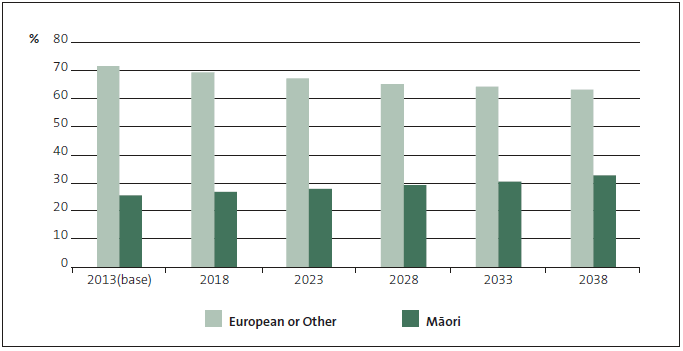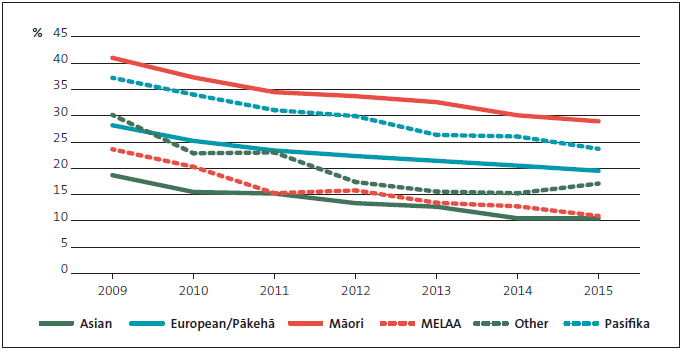Part 1: Māori educational success is in the interests of all New Zealanders
Every child in New Zealand deserves to thrive physically, academically, socially, and culturally. Achieving their potential is important for them and for every New Zealander, because our future prosperity depends on an educated workforce. Therefore, it is important that the education system serves all students well.1
1.1
Not all school students in New Zealand are achieving their full potential. In particular, Māori students are missing out compared to their peers.
1.2
In August 2012, we outlined our intentions to take a thorough look into this significant challenge that New Zealand faces: see Education for Māori: Context for our proposed audit work until 2017.
1.3
We chose the topic of Māori education because there are still disproportionate numbers of Māori children not reaching their full potential in our education system, even though it is so important for them to succeed.
1.4
The number of Māori students is growing. By 2030, the proportion of children who are Māori is likely to increase to about 30%, and this growth is forecast to continue, as shown in Figure 1.
Figure 1
Population projections for European and Māori aged from 0 to 14 years, 2013-2038

Source: Statistics New Zealand, median ethnic population projections. Note: The number of Māori children (aged 0-14 years) is projected to remain stable between 2001 and 2016 before increasing by 9000 to 225,000 in 2021. Source: Statistics New Zealand, Future Māori population - summary of latest trends.
1.5
Academic results for Māori students are improving. However, without effective action, increasing numbers of Māori children will finish school worse off than their peers. This could adversely affect their quality of life and prevent them from fully contributing to a more equitable and prosperous New Zealand.
1.6
In our view, it is important that our education system enables and supports all children, so they achieve their full potential. It is in the interests of all New Zealanders that young Māori thrive and achieve educational success as Māori.
Our work on Māori education since 2012
1.7
When we started our work on Māori education, we were under no illusions that improving the education system to support Māori students to reach their full potential is a big and complex challenge – many people have tried and many, thankfully, are still trying. To understand the challenge and how we could add value, we prepared a set of questions as a framework to guide our selection of audit activity under one over-arching and important question:
How well does the education system currently support Māori students to achieve their full potential and contribute to the future prosperity of New Zealand?
1.8
Our work has resulted in five reports, including this final summary report, which brings together what we have learned and what the education system has done to improve Māori student achievement in recent years, as well as what lessons and challenges remain. The other four reports in the series are:
- Education for Māori: Context for our proposed audit work until 2017 (2012);
- Education for Māori: Implementing Ka Hikitia – Managing for Success (2013);
- Education for Māori: Relationships between schools and whānau (2015); and
- Education for Māori: Using information to improve Māori educational success (2016).
1.9
During our work on Māori education, we built enduring relationships and experienced rich and enlightening dialogue with agencies and people within and close to the education system. For the first time, we reached out directly to schools and whānau to get their views about school-whānau relationships, and we drew on the insights and wisdom of our esteemed Māori Advisory and Reference Group.
1.10
During this time, we have seen advances in the education system to support Māori student achievement, heard ideas and plans, and seen the commitment of people who want to make a difference to outcomes for Māori students. We made recommendations in two of our reports and have seen some of those already being used to encourage good practices.
Gains in Māori student achievement since 2008
1.11
Since the Government's main education strategy for improving Māori achievement, Ka Hikitia – Managing for Success (Ka Hikitia), was launched in 2008, there have been gains in Māori student achievement. The latest data available shows that:
- The percentages of Māori students achieving at or above the National Standards between 2013 and 2015 have progressed from 68.7% to 68.8% in reading, from 64.6% to 65.4% in mathematics, and from 60.8% to 61.6% in writing.
- In National Certificate of Educational Achievement (NCEA) results, the percentage of Māori school leavers with a Level 2 qualification increased from 45.7% in 2009 to 62.2% in 2015, a gain of 16.5 percentage points in six years. This can be compared to increases for European/Pākehā school leavers with Level 2 NCEA qualifications – up from 72.8% in 2009 to 83% in 2015, and Asian school leavers – up from 82.7% in 2009 to 90.6% in 2015.
- Since 2009, Māori students displayed the largest improvement (up 7.2 percentage points) in the proportion of students remaining at school until age 17. The gap in retention between Māori and non-Māori has closed by 2.8 percentage points since 2009. Nevertheless, in 2015, the lowest proportion of students remaining at school to age 17 (69.8%) were Māori.
1.12
Figure 2 shows the percentage of students by ethnic group who leave school with less than an NCEA Level 1 qualification.
Figure 2
Percentage of students leaving school with less than NCEA Level 1

Source: Ministry of Education, Education Counts. Note: MELAA refers to Middle Eastern/Latin American/African.
Our overall conclusions
1.13
In our view, significant improvement in Māori student achievement is a realistic objective.
1.14
However, progress on Māori education is still too slow. The disparity between Māori and non-Māori is too great, and too many Māori students are still leaving our school system with few qualifications.
1.15
We urge the education sector to:
- do more to enable greater and faster gains in Māori student achievement;
- share and learn from the better-performing schools;
- properly implement the Ka Hikitia Māori education strategy in all schools;
- continue to support the growth of better relationships between schools and whānau;
- make better use of information to help improve Māori student achievement; and
- lead a more co-ordinated effort to share good practices and to collect and use information to inform decisions and better support Māori students.
1.16
We discuss these matters in more detail in the rest of this report.
1: Controller and Auditor General (2012), Education for Māori: Context for our proposed audit work until 2017, page 5.

